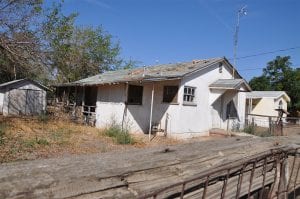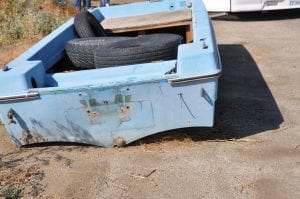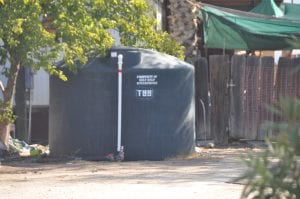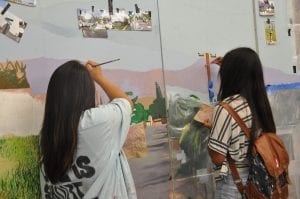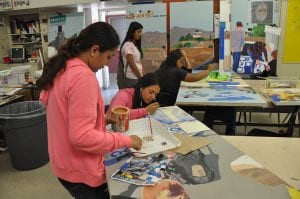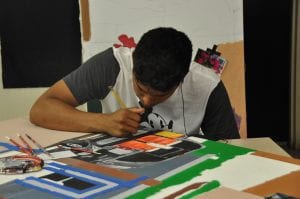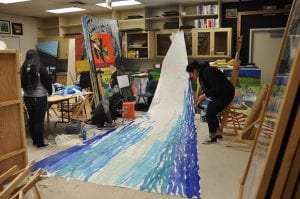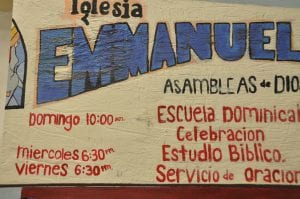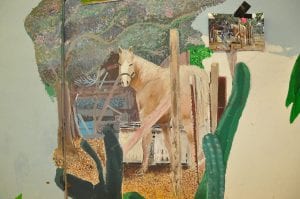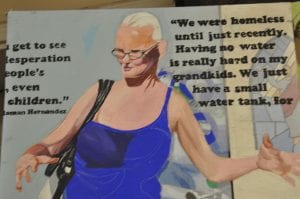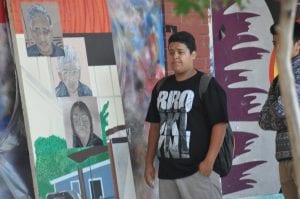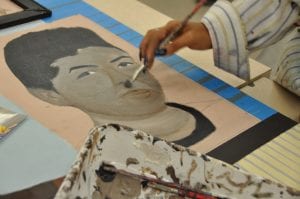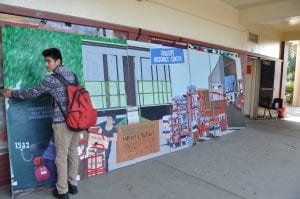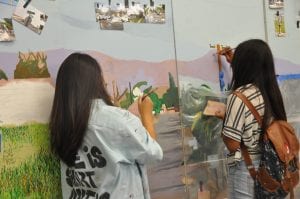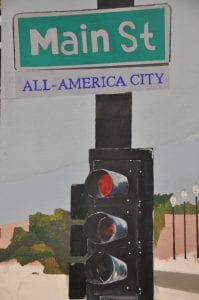Artist Statement
GroundWaterZero began with a trip to East Porterville during the summer of 2015. ArtVenture teachers went directly to the Tulare County Drought Center off Leggett Avenue (the line of demarcation for the area where wells are failing in East Porterville). The drive through the neighborhood streets of unincorporated East Porterville, the area the media was referring as the ‘epicenter of the drought’, was most compelling.
We walked down several streets. It was mid-summer, dry, dusty and brown. You could sense the pall of the drought. What stood out was the large, 2500 gallon water tanks placed in many yards; all the water infrastructure… the piping, the pumps and the boxes of bottled water stacked in driveways, porches, in front of doors and outside gates. This information along with some photographs were taken back to our ArtVenture team and a proposal was made to consider East Porterville and the human impact of the drought as our project for the year. Our team enthusiastically agreed. We selected two anchor texts (class sets) for the project: Cadillac Desert, by Marc Reisner, a history and analysis of the history of water in the West, and Water Consciousness, How We All Have to Change to Protect Our Most Critical Resource, by Tara Lohan. This book includes in-depth essays that illuminate what we can do as individuals to reverse the water crisis…how we think about water but also to change how we live with and use water every day. Within the first weeks of opening school, the ArtVenture staff went down to East Porterville for research. Several experts on the drought made presentations. Soon after making the trip with ArtVenture staff, we arranged to take a charter bus full of students down to East Porterville. The first half of the day was spent with students walking the neighborhoods. Armed with cameras and notebooks, their task was to document their experience in photographs and interview residents. The second half of the day was spent at Iglesia Emmanuel, the church whose parking lot served as The Drought Center for Tulare County. We arranged for several people from the county and the city of Porterville to speak to our students. It is here that we met Donna Johnson, dubbed by the media as “The Water Angel”. Donna was instrumental in arranging for our AV staff and students to enter the homes and lives of the people of East Porterville. Over the next few months we made several trips to conduct interviews and take photographs as reference material for art making. Art teachers decided to produce art based on the drought landscape. Students in art classes created desert dioramas depicting trains and graffiti (water sustainability texts) in desert environments, time lapse topographical paintings showing the before and after impact of the drought in California, and a large mural comprised of mixed media paintings arranged to take viewers on a tour of East Porterville through thirty two canvas panels. The mural begins at the intersection of the 190 and 99 freeways, driving east into downtown Porterville, entering the neighborhoods of East Porterville depicting the water infrastructure, The Drought Center, and finally into the homes of the residents. The tour ends (last ten panels) with the intimate portraits of East Porterville residents telling their stories of the human impact of the drought. Our English teacher had students conduct research then develop spoken word performances along with creative writing. Our band teacher decided to use percussion sounds to create original music using the displacement of water and water-container instruments. Our theater teacher developed live art performances based on the interviews and experiences of East Porterville residents. Our video production students developed several documentaries on various aspects of the drought, one of which was awarded a Student Emmy Award. And lastly, the ArtVenture drought project leadership students wrote a live art performance entitled, “I Am Aquifer”, a dramatic allegorical presentation of our water table underfoot…“the vast amounts of water sitting in underground aquifers, a legacy of the Ice Ages and their glacial melts, which will be mostly gone within a hundred years.” –Cadillac Desert. This project is dedicated to the residents of East Porterville. Art Teacher: Marc Patterson Art Teacher: Jessica Ketchum Art Teacher: Rommel Contreras Video Production Teacher: Manuel Bonilla Drama Teacher: Eric Day Band Teacher: Megan Day ELA Teacher: Donny Garcia
Project Details
Mixed media installation: paintings, assemblage, drawings, murals
Exhibit: Fresno Pacific University and Fresno Art Museum (2009-2011)
Sixty recycled doors were used as supports. Images came from photographs taken primarily of the Fresno encampment near the Freeway 41 overpass. The door panels were assembled in the exhibit to replicate how the homeless erected their shanty homes. We also built a shanty gallery, an 8 x 10 foot room out of found materials. The outside was covered in murals of local homeless people. Inside the shanty artwork was embedded in the walls.
Check Out the Process
Final Project
Poetry
The Aquifer Allegory
I was here, between the two great mountains, rich in the sediments washing down to the valley with great blue rivers and great lofty animals that roamed above me through the grasses and the marshes of prehistory. I was here when the land was lush then dry, then lush again, eons upon eons. I am Aquifer deep and dark, clean and constant beneath the fertile ground. I am tiny rivulets trickling down, ancient pools resting in the quiet hollows of the earth. I am the sustenance coursing upwards through vein-like capillaries to nourish teeming life above. Mother to many, quiet nurturer . . . Content to live in the hollow and sacred recesses below… supporting the land where the old roses grow, where the blackberry bushes bend and bow. . . .where the majestic oaks block the sun… ..where song birds caroled sweetly to the cool breeze after the spring floods. The seasons flew upon the mountains overhead. Then it happened, one quiet summer, the rumble above me, and things begin to change. I felt a “taking”, a gentle sapping of my lifestream… more and more, year after year. As time came and went, I became weaker, then my husband, Sweet Rain and Blanketing Snow, left me. I was alone. The demands upon my lifestream increased. The birds didn't sing among the grasses. The green began to fade…I felt a growing emptiness, a loss, an ebbing as if my life was being sucked out of me. How could this be? I’ve been here for centuries! I was strong. Weakness seeped within my pools. Was the land above me robbing me of my life? When will my husband return? I miss him now. His constant nurturing coming down, the steady exhilaration, fulfilling. Where did it go? Where did my husband go? He’s been my helpmate, my companion, nourishing the great mountains, the beautiful valleys teeming with life for ages above me. Beautiful loams and clays…sediments rich beyond belief, drying and cracking and barren. Verdant grasses gone, burnt and hollow on the bare dirt. A beautiful memory is fading. I feel weak. What was I becoming? The blue lakes gone. Ponds… a home to the fish and beautiful white herons gone. My husband is gone…the blue rivers retreated, the cool breezes became hot, the birds lost their sweet choruses. My husband is gone. I am alone. Nothing to replenish, nothing to share…and they keep taking. I still have some to give, but they go deeper and deeper, sucking the deep blues of my lifestream down to the bedrock. Who will nourish now? Who will slake the thirst? Who will strengthen the weak? Who?
The Water Angel
They call me The Water Angel.
I don’t know about that.
I’m no angel.
This is my home, my community. These are my friends, my neighbors.
I am just a pair of legs and hands and feet.
I’m no angel. I’m just a person. A neighbor.
It all started at the corner store. There was a list, names of families whose wells went dry, who ran out of water. Wells were going dry, each day the list was growing, every day another house, another well went dry. More families…older people, working people, families with young children, people that were sick. Field workers. Renters. Honest, hardworking people.
How can people live without water?
Then it happened…my well went dry.
I looked around. I asked around. There were no legs, no hands no feet. Nobody was speaking. Nobody was listening. Nobody was helping. I went door-to-door, asking people if they had water. The list continued to grow. I went to meetings…to listen, to speak, to beg, to cry. How can people live without water?”
Suddenly…my phone started to ring. They started to call…the Media…countries from around the World…cameras, lights, microphones…they wanted to know “how can people live without water?” They came. They listened. They wrote.
The brown veil of the drought began to slowly lift.
Water started to flow…..bottles…cases…palettes…truck loads. Some people came to the church to get the water. Many did not. How can people live without water? So I loaded my truck, case by case, day after day, and took the water to them. Down each street and alley, house to house, porch to porch. I got so tired. I parked in the middle of the street and the people would come to me, for water.
They call me the Water Angel. I’m no angel. I’m just a pair of legs, a pair of feet and hands. I’m just a neighbor. They are thirsty.
How can people live without water?
Media
The video production students developed an extensive documentary on the drought in East Porterville. The finished video won a student Emmy.




